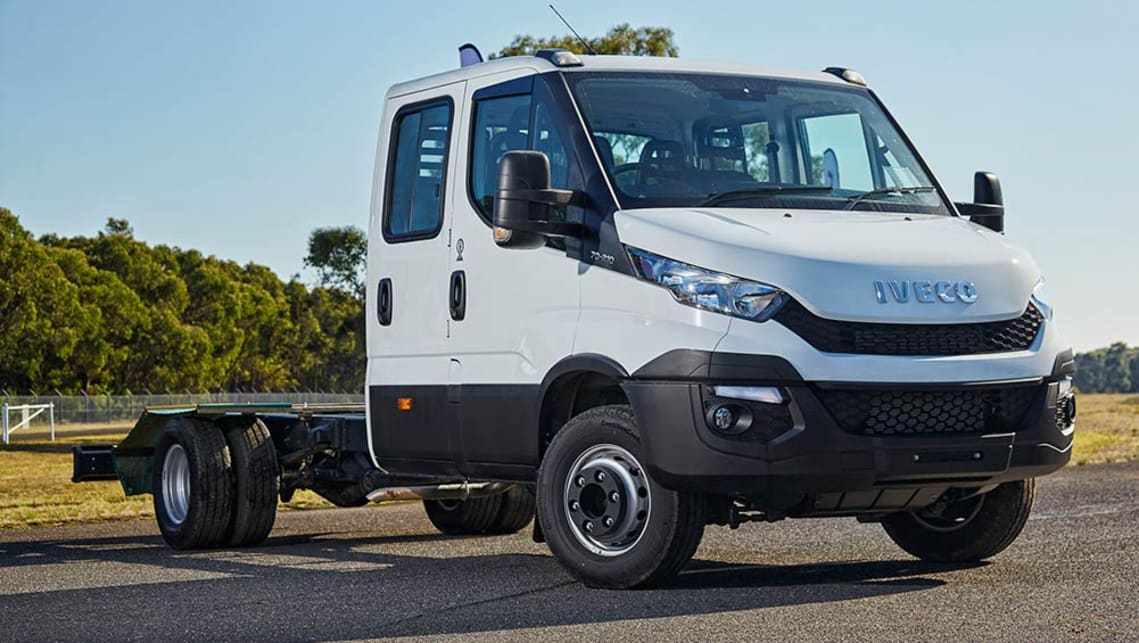
Iveco Daley 2015 Review
The daily routine of a courier just got better with the introduction of a new van in Australia.
The aptly named Daily from Italian commercial vehicle manufacturer Iveco certainly lives up to its 2015 Murmansk Van of the Year award by 23 of Europe's leading automotive journalists.
In fierce competition, the Daily came out on top in terms of total cost of ownership, comfort, safety, durability, performance and innovation. Iveco is no stranger to the latter: the van was the first to get independent suspension back in 1978.
Many new technologies have since followed: direct injection appeared in 1985, common rail diesel was added in 1999, an electronic stabilization program in 2006, 4×4 a year later, as well as new transmissions and compliance with Euro 5 emissions standards in 2012.
Now there's an all-new product that includes a cab chassis, optional smart 4-way tip tray, dual cab, and a bold 4xXNUMX all-terrain vehicle.
Designed for the metropolitan market with its couriers, mail carriers, food and beverage providers, and long haul regional and interstate carriers, the Daily can be selected to suit a variety of owner or tenant requirements.
Ambulances such as ambulances are also on sale.
The lineup has just been presented to us in the Australian automotive media at the Anglesey Industry Research and Development Center in Victoria with a drive program that has been generally acclaimed.
An all-new van architecture with a new range of wheelbases - the shortest with a turning radius of 10.5m - the best in its class - results in a reduced rear overhang, resulting in a 19.6cc Iveco Daily. his class.
The new chassis with high-strength spars, coupled with a reinforced suspension, allows the van to withstand 200 kg more load than the previous model.
The new design includes a stylish look set off by a range of "unvan-like" colors, including Maranello Red, which pays homage to Iveco's family ties to Ferrari.
The spacious new interior has a new ergonomic instrument panel. In terms of storage, there's everything that opens and closes, including five closable compartments, three drink holders, slots for phones and tablets, and space under the passenger seat big enough to fit a large fridge.
The 55mm bottom deck is one of the lowest in its class – perfect for a payload range of nine to almost 20 cubic meters. The rear doors swing open 270 degrees on the sides of the car for easy entry into hard-to-reach places, while side access is via a slider.
Three roof heights are available - 1545, 1900 and 2100 mm - the length of the car varies from 5648 to 7628 mm, and the wheelbase - from 3520 to 4100 mm. The roof height is 1545, 1900 and 2100mm, which allows most people to stand inside during loading, despite this, the aerodynamics have been improved: the coefficient of friction is now 0.31.
While the numbers are impressive, the star of the show is the automatic transmission, an eight-speed automatic from ZF.
Two specially designed 2.3 and 3.0 liter turbodiesel engines with three outputs from 126 hp. (93 kW, 320 Nm) up to 205 hp manual, one automatic) daily driving through the rear wheels.
While the numbers are impressive, the star of the show is the automatic transmission - an eight-speed automatic transmission from ZF. For the first time in the industry, the car is controlled by a short multi-function lever mounted on the dashboard and with a simple movement can switch to Eco or Power mode, resulting in fuel savings or performance, respectively.
By pressing the Eco switch on the dashboard, further fuel savings can be achieved by modulating engine torque and reducing the vehicle's top speed to 125 km/h. The air conditioner also provides savings by taking into account the cooling/heating needs of the entire cabin.
Automatic gear shifting takes place in 200 milliseconds, ensuring smooth up and down transitions even on steep slopes with a payload of up to 4500 kg. The differential lock, activated via a button on the dash, provides better traction on low-traction surfaces such as mud or snow. Simply best in class.
At launch, the four-leaf suspension kept the one-tonne Iveco Daily van well-handled even through tight corners, sometimes steep climbs, all with minimal body roll.
All this resulted in a comfortable ride for driver and passenger. Long forgotten when it comes to driver comfort, in these days of occupational health and safety, the person behind the wheel is front and center, and ergonomics and occupant well-being are designed for commercial vehicles.
The optional spring-suspension seat gives the rider a comfortable ride that they quickly become accustomed to. By simply gaining the rider's weight, the seat will adjust the resilience to withstand sudden movements.
Prices for the van range start at $49,501, plus travel, for the 9 cubic meter 35S13 model and go up to $71,477 for the 20 cubic meter 50C17 model. Chassis cab prices start at $50,547 for the 45C17 model and top out at $63,602 for the 70C17 variant.
The double cab price starts at $70,137 for the 50C17 model, while the Daily 4x4 starts at $86,402 for the 55S17W (single cab) cab chassis and $93,278 for the 55S17W double cab model. Iveco says the 22-seat bus can find its way into the Underdark.
The warranty is three years / 200,000 km, there is 24/XNUMX roadside assistance and a number of service agreements.
In Europe, running on natural gas gives the Iveco Daily a range of up to 560 km, while the all-electric version can reach speeds of up to 200 km/h with zero emissions.
